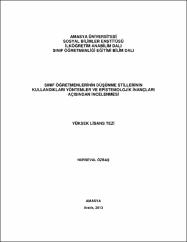| dc.contributor.advisor | Sağır, Şafak Uluçınar | |
| dc.contributor.author | Özbaş, Nurseval | |
| dc.date.accessioned | 2022-03-09T14:55:53Z | |
| dc.date.available | 2022-03-09T14:55:53Z | |
| dc.date.issued | 2013 | |
| dc.identifier.uri | https://tez.yok.gov.tr/UlusalTezMerkezi/TezGoster?key=1zw6GvYMe-q3Hf6HR-3US8pvsT7ZacHAurBuelsl88_CZMuCtY38Q8F2TP_1E5F4 | |
| dc.identifier.uri | https://tez.yok.gov.tr/UlusalTezMerkezi/EkGoster?key=6ZtRe5rnHrr74rjfYBQv_jlo7Lb5jvNkVEqkF4ZwJx77NScv7h6l6HA9tNfwNVsY | |
| dc.identifier.uri | https://hdl.handle.net/20.500.12450/1707 | |
| dc.description.abstract | Bu çalışmanın amacı, sınıf öğretmenlerinin düşünme stillerini, kullandıkları öğretim, ölçme-değerlendirme yöntem ve tekniklerini, epistemolojik inançlarını ve bu değişkenlerin birbirleriyle olan ilişkilerini incelemektir. Çalışmada ilişkisel tarama modeli kullanılmıştır. Araştırmanın evrenini 2012-2013 akademik yılında, Amasya ilinde görev yapmakta olan sınıf öğretmenleri, örneklemini ise 375 sınıf öğretmeni oluşturmaktadır. Araştırmada veri toplamak amacıyla Sternberg-Wagner (1992) tarafından geliştirilen, Türkçe geçerlik, güvenirlik çalışmaları Buluş (2005) tarafından gerçekleştirilen "Düşünme Stilleri Ölçeği", epistemolojik inançları belirlemeye yönelik olarak ise Schommer' in (1998) geliştirip Karhan (2007) tarafından Türkçeye uyarlaması yapılan "Epistemolojik İnanç Ölçeği" kullanılmıştır. Bunun yanı sıra araştırmacı tarafından hazırlanan kişisel bilgi formu ve öğretmenlerin kullandıkları öğretim, ölçme-değerlendirme yöntem ve tekniklerini belirlemeye yönelik form kullanılmıştır. Verilerin analizinde tanılayıcı analizler, t-testi Tek Yönlü Varyans Analizi, Pearson Korelasyon ve Ki-Kare analizleri kullanılmıştır. Araştırma bulgularına göre, sınıf öğretmenleri çoğunlukla, yasama, yürütme ve hiyerarşik düşünme stillerine sahipken; en az muhafazakâr, global ve lokal düşünme stillerine sahiptirler. Düşünme stilleri sınıf öğretmenlerinin cinsiyet, mesleki kıdem ve mezuniyet branşına göre farklılaşmamaktadır. Sınıf öğretmenleri öğretim yöntem ve tekniklerinden en çok, soru cevap ve anlatım yöntemini kullanırken, en az istasyon, altı şapka ve analoji tekniğini kullanmaktadırlar. Ölçme-değerlendirme yöntem ve tekniği olarak ise en çok kullanılanlar, çoktan seçmeli, kısa cevaplı açık uçlu ve boşluk doldurmalı soruları iken; en az veya hiç kullanmayanlar ise bulmaca, günlük, yapılandırılmış grid ve tanılayıcı dallanmış ağaç olarak belirlenmiştir. Araştırmada bir diğer değişken olan epistemolojik inançlar incelendiğinde, sınıf öğretmenlerinin daha çok olgunlaşmış bilim anlayışına sahip oldukları görülmüştür. Düşünme stilleri ile diğer değişkenler arasındaki ilişkiler incelendiğinde; belirli bir düşünme stilinin baskın olarak kullandığı öğretim, ölçme-değerlendirme yöntem ve tekniği bulunmadığı belirlenmiştir. Sadece bazı düşünme stilleri ile öğretim, ölçme-değerlendirme yöntem ve teknikleri arasında anlamlı ilişkiler bulunmuştur. Düşünme stillerinin epistemolojik inançlarla arasında anlamlı bir ilişkili görülmemiştir. Düşünme stillerinin ve epistemolojik inançların alt boyutları arasında düşük ve orta düzeyde anlamlı ilişkiler bulunmuştur. | en_US |
| dc.description.abstract | The aim of this study is to investigate the effects of the thinking styles of the class teachers, the methods and techniques of teaching and assessment and evaluation which they use, their epistemological beliefs and the relations of these variables with each other. In the study, relational survey model was used. The study population consists of class teachers who were on duty in 2012-2013 academic year in Amasya and the sample constitute of 375 class teachers. With the aim of data collection, "Thinking Styles Scale" which was developed by Sternberg-Wagner (1992) and whose validity and reliability studies were conducted by Buluş (2005) in Turkish, and for the identification of epistemological beliefs "Epistemological Belief Scale" which was developed by Schommer (1998) and adapted by Karhan (2005) in Turkish were utilized. Besides, personal information form that was prepared by the researcher and the form which was aimed to determine the methods and techniques of teaching and assessment and evaluation, which were used by the teachers, were also utilized. Descriptive analyses, independent sample t-test,oneway analysis of variance, pearson correlation, chi-squared analyses were used for the data analytics. According to the findings of the study, class teachers had mostly legislative, executive and hierarchical, etc. thinking styles as well as the most conservative, global and local thinking styles. Thinking styles did not differentiate in terms of gender, occupational seniority and graduation branch. Class teachers used at most the question-answer and expression method and at least station, six thinking hats and analogy methods from the teaching methods and techniques. They used mostly multiple-choice and short answered, gap-filling questions; the ones at least or never used were identified as being crossword, diary, structured grid and diagnostic tree. When the epistemological beliefs, which were one of the variables of study, were inspected, it was seen that the class teachers had mostly a matured understanding of science, despite of the fact that they partially had a conventional understanding of science. When the relations between thinking styles and other variables were examined, there were not any methods and techniques of teaching and assessment and evaluation in which any certain thinking style was used dominantly. There were only meaningful relations between some thinking styles and methods of assessment and evaluation. It was also found that thinking styles were related to the epistemological beliefs positively from weak aspect. There were weak or medium level meaningfull relationships between subdimensions of thinking styles and subdimensions of epistemologic views. | en_US |
| dc.language.iso | tur | en_US |
| dc.publisher | Amasya Üniversitesi | en_US |
| dc.rights | info:eu-repo/semantics/openAccess | en_US |
| dc.subject | Eğitim ve Öğretim | en_US |
| dc.subject | Education and Training | en_US |
| dc.subject | Düşünme stilleri | en_US |
| dc.subject | epistemolojik inanç | en_US |
| dc.subject | sınıf öğretmeni | en_US |
| dc.subject | öğretim yöntem ve teknikleri | en_US |
| dc.subject | ölçme-değerlendirme yöntem ve teknikleri | en_US |
| dc.subject | Thinking styles | en_US |
| dc.subject | epistomologic views | en_US |
| dc.subject | class teacher | en_US |
| dc.subject | teaching methods and techniques | en_US |
| dc.subject | assessment and evaluation methods and techniques | en_US |
| dc.title | Sınıf öğretmenlerinin düşünme stillerinin kullandıkları yöntemler ve epistemolojik inançları açısından incelenmesi | en_US |
| dc.title.alternative | Investigation of class teachers' thinking styles through the methods they used and epistemological beliefs | en_US |
| dc.type | masterThesis | en_US |
| dc.department | Enstitüler, Sosyal Bilimler Enstitüsü, İlköğretim Ana Bilim Dalı | en_US |
| dc.identifier.startpage | 1 | en_US |
| dc.identifier.endpage | 134 | en_US |
| dc.identifier.yoktezid | 353338 | en_US |
| dc.institutionauthor | Özbaş, Nurseval | |


















